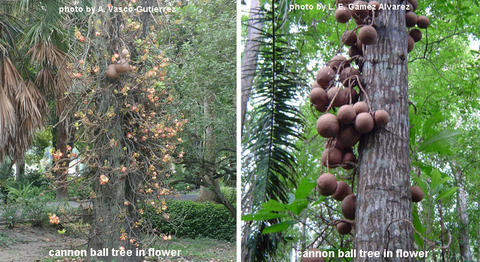This article was contributed by Scott A. Mori

The cannon ball tree is one of the more spectacular South American trees to be planted in subtropical and tropical botanical gardens throughout the world. This magnificent tree can be seen in cultivation at the Fairchild Tropical Botanical Gardens in Coral Gables, Florida. The species was given the name Couroupita guianensis in 1775 by the French botanist J. F. Aublet and is a member of the Brazil nut family (Lecythidaceae). The cannon ball tree is planted in tropical and subtropical botanical gardens because the flowers are large, beautiful, pleasantly aromatic, and unlike any other flower a newcomer to the tropics has ever seen. Even the fruits are a botanical curiosity because they are in the shape and size of cannon balls that, like the flowers, arise from the trunk of the tree. In contrast to the flowers, they release a foetid aroma when they hit the ground and break open.
POLLINATION
The flowers of C. guianensis are without nectar and are mostly visited by bees in search of pollen. The structure of the male part of the flower is not found in any other plant family in the world except for other species of the Brazil nut family. In the cannon ball tree, fertile stamens are found in a ring around the reduced style and stamens with sterile pollen are located in the antherodes of staminodes located in the ligule (a prolongation from one side of the staminal ring that arches over the ovary). Carpenter bees (Xylocopa brasilianorum) have been reported as the principal pollinators outside of the native habitat and range of the cannon ball tree in the botanical garden of the Museu Nacional in Rio de Janeiro. The large black carpenter bees enter the flowers with their ventral side toward the sterile stamens of the hood and their head and backs against the ring with fertile pollen and, as a result of their position, they are dusted with pollen on their heads and back. The two types of pollen were first described as being different in 1825 by the French botanist Pierre Antoine Poiteau who was one of the first to recognize the family Lecythidaceae in the same publication. The morphological and physical differences of the pollen have been demonstrated by several botanists since that time. The most important pollen difference is that the pollen of the ring stamens germinates and is fertile while the hood pollen does not and is sterile. Thus, hood pollen has become specialized as the reward to attract pollinators to the flowers. In turn, the fertile pollen is transferred to the next flowers the bees visit and as a result fruits and seeds develop. Most fruits of this species in nature are probably the result of the movement of pollen from one tree to another, but experiments show that self-pollinated plants of the cannon ball tree also set fruit.
DISPERSAL
The cannon-ball like fruits of C. guianensis fall from the tree at maturity and often crack open upon hitting the ground. The seeds are embedded in a six-segmented, fleshy pulp that oxidizes bluish-green and emits an unpleasant aroma when exposed to the air. Peccaries and domestic animals, such as chickens and pigs, are reported to eat the pulp and in so doing swallow the seeds. Observation of a tree under which the ground was covered by many fruits revealed that they remained untouched until a herd of peccaries passed by and broke open the fruits and consumed the pulp. Presumably the peccaries pass the seeds in their feces and some of the seeds germinate. The seeds of species of Couroupita have hairs on their seed coats which may protect them from digestive juices and facilitate their passage through the digestive tracts of animals.
FURTHER READING
Mori, S. A., J. E. Orchard & G. T. Prance. 1980. Intrafloral pollen differentiation in the New World Lecythidaceae. Science 209: 400-403.
Citation
MODIFIED FROM:
Mori, S. 2012. Cannon ball tree (Couroupita guianensis). Encyclopedia of Earth.
HOW-TO-CITE:
Mori, S. A. 2013. Cannon ball tree. The Brazil nut family (Lecythidaceae). http://lecythidaceae.myspecies.info/taxonomy/term/18#overlay=node/8.
Add new comment